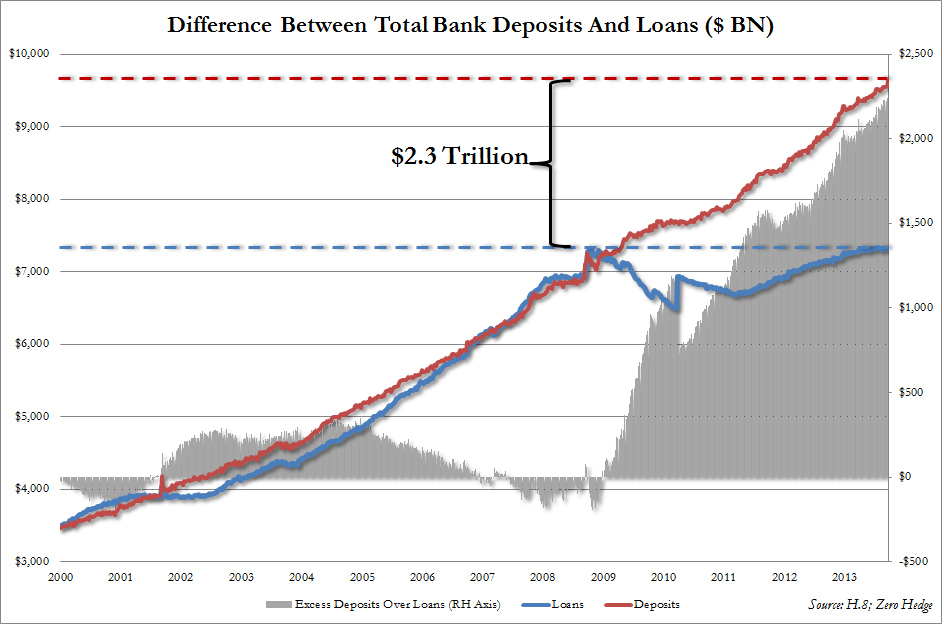– The Biggest Banking Disconnect Since Lehman Hits A New Record (ZeroHedge, Oct 10, 2013):
As regular readers know, the biggest (and most important) disconnect in the US banking system is the divergence between commercial bank loans, which most recently amounted to $7.32 trillion, a decrease of $9 billion for the week, and are at the same the same level when Lehman filed for bankruptcy having not grown at all in all of 2013 (blue line below), and their conventionally matched liability: deposits, which increased by $60 billion in the past week to $9.63 trillion, an all time high. The spread between these two key monetary components – at least in a non-centrally planned world – which also happen to determine the velocity of money in circulation (as traditionally it is private banks that create money not the Fed as a result of loan demand) is now at a record $2.3 trillion.
Which, of course, also happens to be the amount of reserves the Fed has injected into the system (i.e., how much the Fed’s balance sheet has expanded) since the great experiment to bailout the US financial system started in September 2008, in which Ben Bernanke, and soon Janet Yellen, stepped in as the sole source of credit money. The only difference is that while the Fed is actively pumping bank deposits courtesy of the fungibility of reserves, loan are unchanged.
For those who still don’t understand the identity between Fed reserves and bank deposits, here is Manmohan Singh with the simplest explanation on the topic:
When central banks buy securities, one of the immediate effects is to increase bank deposits, which adds to M2 (in the U.S., practically the Fed has bought from nonbanks, not banks). Whether banks maintain those added deposits as deposits, or convert them into other liabilities (or, by calling in loans, reducing or moderating the growth of their balance sheets), is an open question.
Actually it’s not. As the JPM London Whale episode taught us, it is the excess deposits on bank balance sheets courtesy of the Fed, that serve as collateral for marginable derivatives (IG9, HY9, ES, etc) which then can and are used by banks to chase risk higher, often with leverage that runs into the orders of magnitude. In other words, as the chart below shows, in the past week, the Fed injected a net $69 billion in risk-ramping power on the commercial bank balance sheets, and, more importantly, since the failure of Lehman, this amount is a record $2.308 trillion.
So for those confused where the money comes from to ramp equities ever higher on a daily basis for the duration of QE, and why the S&P correlates (and “causates”) exquisitely with the Fed’s balance sheet, now you know. More impotantly: don’t expect banks to lend out much if any real new loans as long as they can generate far greater and far less riskier returns simply by chasing risk in the capital markets.

Terrifying house of cards. None of us have ever lived in an era when the banking system has collapsed completely. It happened in 2008, but the FED kept the leaky boats afloat a while longer. In the meantime, instead of investing into stable things, they continue to gamble using leveraged (fictional) funds.
Insane. I don’t see how it can go much longer, but I never thought it would go this long……